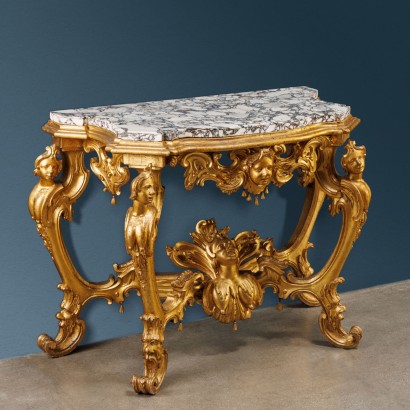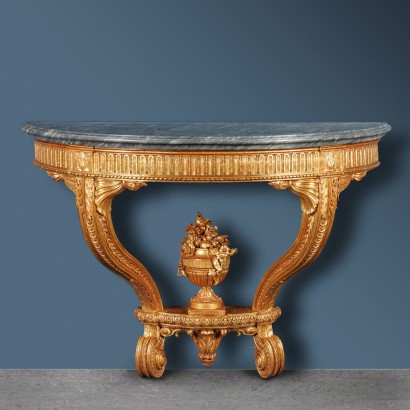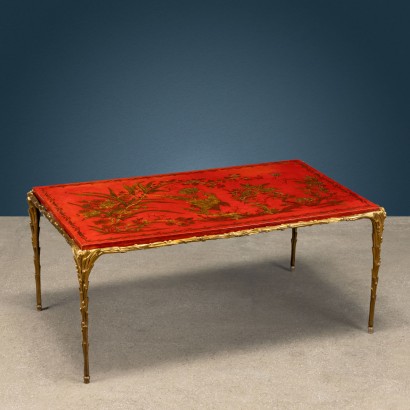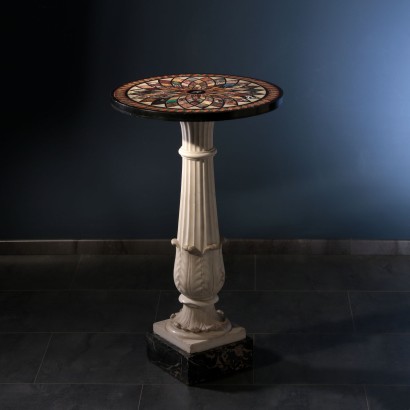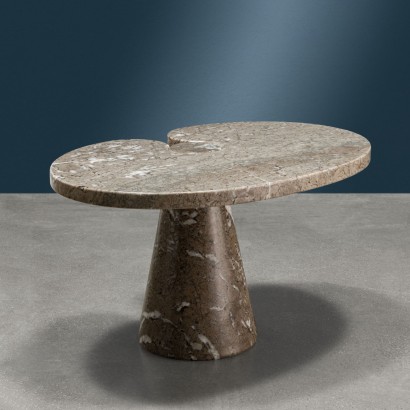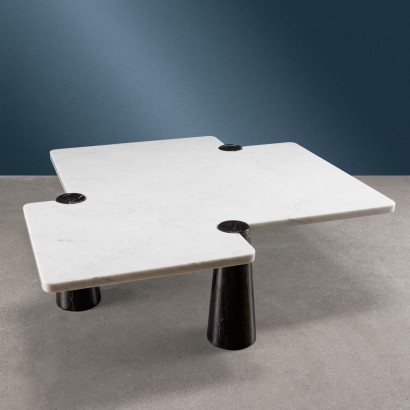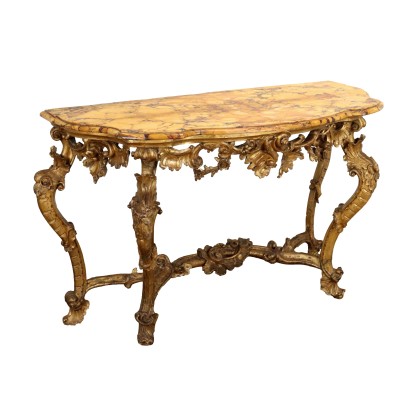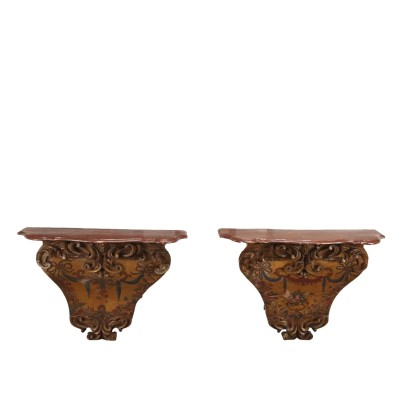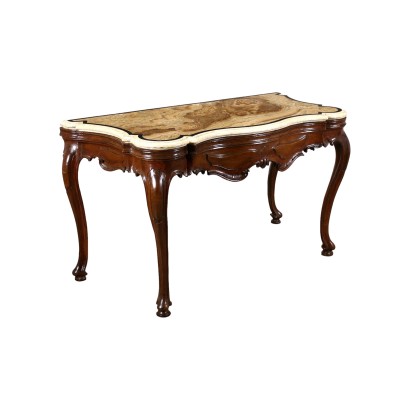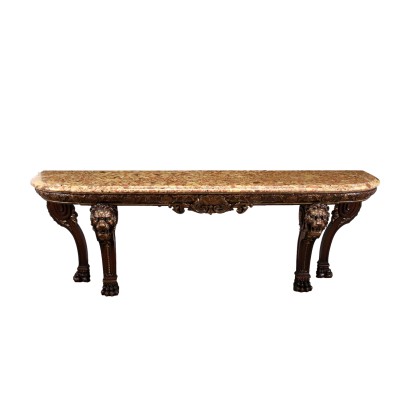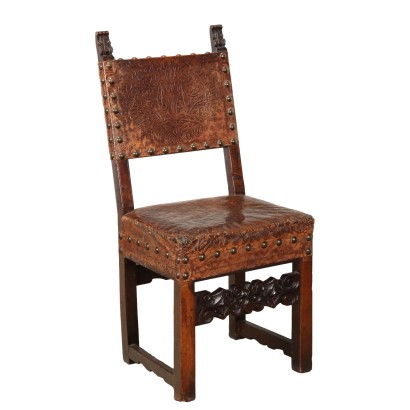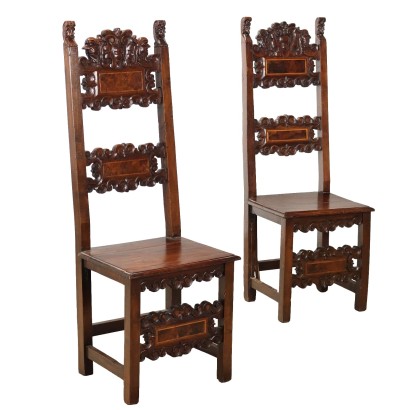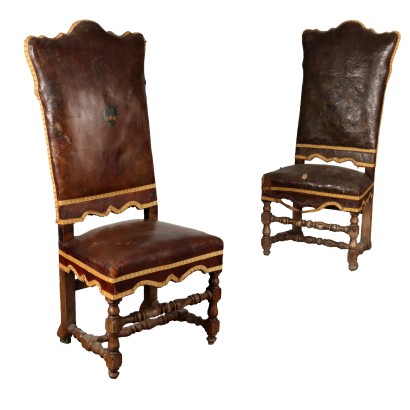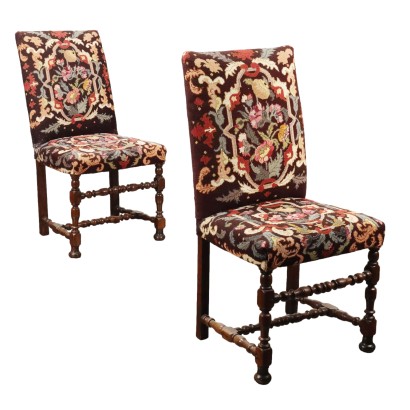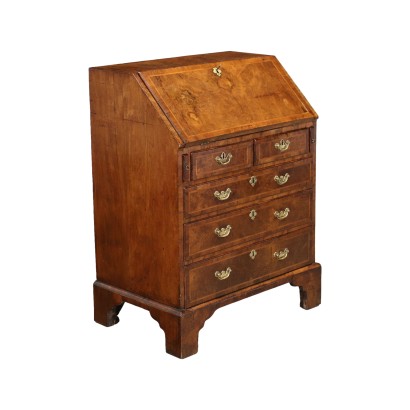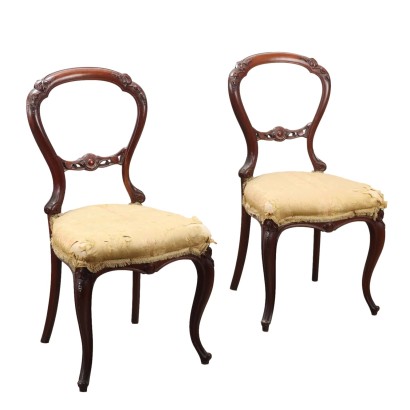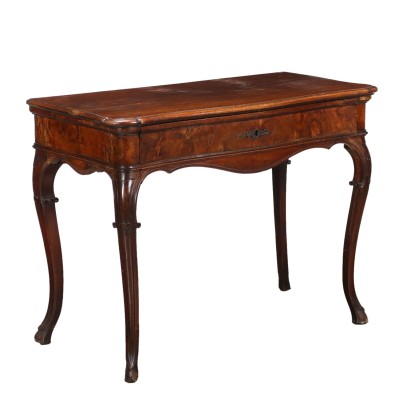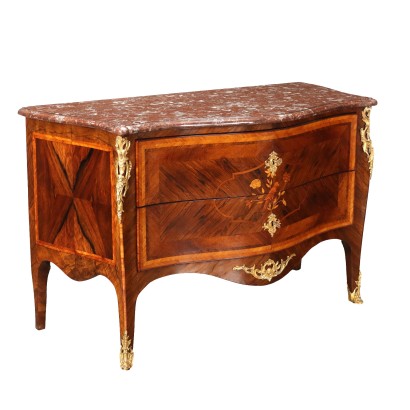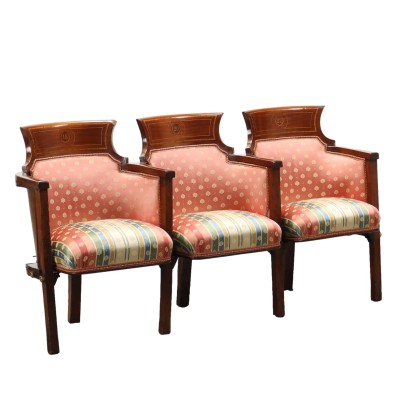Pair of Satyrs - Rome Early 18th Century
Features
Rome Early 18th Century
Style: Baroque (1630-1730)
Age: 18th Century / 1701 - 1800
Origin: Roma, Italy
Description
Two architectural spirals, made up of overlapping curls, act as seats for two satyrs bent and stretched in an effort to support a plane beyond which they look, through the twist of the neck that accentuates the dynamism of the effort. To soften the weight between the arm and the shoulder there is a clump of leaves. They are born in carved lime wood and entirely gilded on the entire surface.
Product Condition:
Product in good condition, with small signs of wear.
Dimensions (cm):
Height: 93
Width: 53
Depth: 48
Additional Information
Notes historical bibliographic
These two sculptures depicting satyrs are most likely born as part of a sculptural apparatus or furniture. They do not show signs of cuts or reduction while they are made to act as a support on the head and on the right forearm folded over the shoulder. Furthermore, they are two symmetrical and not opposed figures. The analysis of these aspects leads us to hypothesize that they were supporting elements of a pair of consoles supported by two or four opposing satyrs, then separated into different elements. The type of sculpture is part of the more mature Baroque style which is expressed in the wake of the ideas of Gian Lorenzo Bernini towards the end of the 17th century and the beginning of the 18th century. We move from the furnishings of the first period, where the composition is dominated by plant and architectural elements, to the creation of large apparatuses where the mythological or human figure, with characters of great dynamism, becomes very present. Sculptures used not only for tables and furnishings, but also for ecclesiastical apparatuses such as choirs or altars and even in representative carriages. From those years are the drawings of the carver Filippo Passarini, published in the New inventions of ornaments…, (Rome, 1698), depicting some proposals for consoles and mirrors (fig. 1). A few years later, in 1714, in the diverse Drawings repertoire…. by the silversmith Giovanni Giardini we still find ideas of tables where figure sculpture dominates as a support. In one of these inventions, two satyrs resting on volutes hold the marble top (fig. 2). The construction of the large tables in the Galleria di Palazzo Colonna in Rome, considered the greatest example of this Baroque production, is also dated between the two centuries. These are undoubtedly the years in which these two sculptures were made. When we talk about the Roman Baroque we cannot forget that in reality the whole peninsula is influenced by this language. This stylistic influence can be observed both in the examples of Giacomo Amato and Antonio Grano in Palermo and in the sculptures of Andrea Brustolon in Venice, where Bernini's lesson is transferred with local influences. Much closer to the original production are the cities of the Papal State but also Florence and above all Genoa thanks to the presence of Filippo Parodi. The latter spent the years of his training in Bernini's workshops and brought what he had learned to his native city by influencing Ligurian taste. In the analysis of these satyrs we have stalled on the choice of provenance in the comparison with some Ligurian creations. Essential elements in indicating the Roman authorship of these works are on the one hand the presence of those large, typically Roman, very free and clear-cut architectural supporting motifs, and on the other the choice of the subject, the faun. As evidenced by the aforementioned drawings, the faun is very present in the Roman repertoire and less in Genoa, where the mythological figure of reference is the triton, due to the evident references to the sea. One of the most beautiful elements of these sculptures, the dynamism of the torsion, which we find for example both in the figures of the tables in the Colonna gallery and in the torch-holding tritons of the Palazzo del Principe in Genoa, attributed to Filippo Parodi, does not help in the choice.Style: Baroque (1630-1730)
Read more
The term derives from the Spanish barrueco phoneme or Portuguese barroco and literally means "shapeless pearl".
Already around the middle of the eighteenth century in France it was synonymous with uneven, irregular, bizarre, while in Italy the term was of Medieval memory and indicated a figure of the syllogism, an abstraction of thought.
This historical period was identified with the derogatory term baroque, recognizing in it extravagance and contrast with the criteria of harmony and expressive rigor to which it was intended to return under the influence of Greco-Roman art and the Italian Renaissance.
Baroque, seventeenth-century and seventeenth-century were synonymous with bad taste.
As regards furniture, freedom of ideation, need for pomp and virtuosity gave rise to a synergy destined to produce unsurpassed masterpieces.
The materials used were worthy of competing with the most astonishing tales of Marco Polo: lapis lazuli, malachite, amber, ivory, tortoiseshell, gold, silver, steel, precious wood essences and more dressed the furnishings that in shape and imagination virtually gave life to the Arabian Nights of many of our powerful people.
Typical of the period were load-bearing or accessory parts resolved with twisted column motifs, clearly inspired by Bernini's canopy of St. Peter's, parts with rich sculptural carving in high relief and even in the round within a vortex of volutes, scrolls and spirals, curved and broken profiles, cymatiums agitated by gables of articulated shape, aprons adorned with ornaments, corbels, buttresses and so on. necessary to enliven shapes and structures.
The Baroque is also the century of illusionism: lacquers and thin temperas crowd furniture and furnishings to imitate with the marbling effects of marble veining or games of veining of precious briar roots.
Find out more about the Baroque with our insights:
Classic Monday: a double-body sideboard, late Venetian Baroque
Classic Monday: a pair of candle holders between the Renaissance and Baroque
Classic Monday: a pair of mirrors between Baroque and Late Baroque
Age: 18th Century / 1701 - 1800
18th Century / 1701 - 1800Other customers have searched:
Approfondimenti
Scopri di più sulle consolle e tavoli parietali con gli approfondimenti del nostro blog e di FineArt:Una superba consolle austriaca
L'attenzione neoclassica per i dettagli in una consolle torinese decorata a pastiglia
Una raffinata consolle demi-lune piemontese neoclassica
L'estetica elegante e raffinata di una Consolle fratinata
Simili ma diverse: una consolle Luigi Filippo e una umbertina a confronto
Consolle a pastiglia
Tavolo parietale, Firenze 1780-1785ca.
Consolle inglese, metà XIX secolo
Consolle parietale
Coppia di consolle in pietre laviche
Consolle anni '50, manifattura italiana
Sull'antiquariato in generale dai un'occhiata anche a
Classic Monday: da un pezzo dei nostri magazzini alla storia dell'antiquariato
Il dizionario dell'antiquariato - Lastronatura
Il dizionario dell'antiquariato - Mascherone
Il dizionario dell'antiquariato - Natura morta
Il dizionario dell'antiquariato - Opificio
Il dizionario dell'antiquariato - Pastiglia
Il dizionario dell'antiquariato - Savonarola
Il dizionario dell'antiquariato - Rosone
Product availability
The product can be seen at Cambiago
Immediate availability
Ready for delivery within 2 working days from ordering the product.




